Air quality – live: New York air ‘worst in the world’ as Canada wildfires smoke fills skies and turns moon red
New York has topped the list of the world's most polluted cities as smoke from over a 100 wildfires raging in Canada continue to fill skies in the northeast and mid-Atlantic regions and turns the moon red.
New York’s Air Quality Index passed 200, which is deemed “very unhealthy”.
At 10pm ET, the city briefly had the worst air quality among major metropolitan areas worldwide, and currently surpasses Doha and Baghdad while trailing behind Delhi and Lahore.
Worsening air quality has prompted health alerts in New York and Quebec with officials warning people about the impact of fine particles known as PM2.5, which can lead to respiratory illnesses.
At least 10 school districts in central New York cancelled outdoor activities, including recess and gym classes.
The moon turned red for residents in the northeastern US, an occurrence directly linked to smoke drifting down from the Canadian wildfires as it appears behind grey, hazy skies.
Canada is currently facing one of its worst wildfire seasons on record, with over 6.7 million acres already scorched since this year’s start.
Key Points
New York City 'worst polluted city' in the world as air quality plummets
Canada facing its 'worst wildfire season ever'
Why did New York residents see the sun and moon turn red?
New York mayor urges vulnerable residents to mask up
Satellite images shows grey smoke covering Northeastern US
Air quality to get worse in New York City later on Wednesday afternoon
17:20 , Louise Boyle
Smoke will become more dense in New York City around 4pm local time on Wednesday, according to forecasters.
It is expected to be worse than it was around the evening commute on Tuesday, the Twitter account New York Metro Weather posted.
Public officials are advising New Yorkers to limit their time outdoors and to wear a mask to protect themselves from the air pollution. Low visibility will also be an issue.
- Limit your time outdoors and especially any strenuous outdoor activities. Wear an N95 mask if possible to filter particles
- Keep a close eye on children, elderly and pets who may be extra sensitive to the smoke
- Keep windows closed and make sure any air filters are changed— New York Metro Weather (@nymetrowx) June 7, 2023
What started the Canadian wildfires?
17:01 , Louise Boyle
Canada is dealing with hundreds of intense wildfires that have spread from the western provinces to Quebec, with many raging out of control.
How did they start?
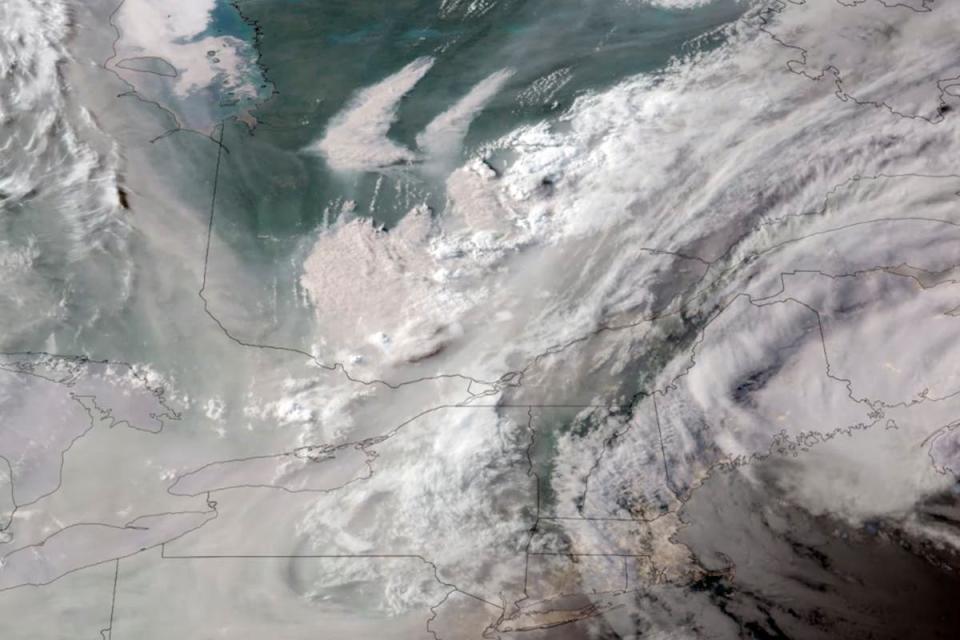
What started the Canada wildfires? All we know about air quality alerts
Quebec orders more evacuations as dozens of wildfires in Canada remain out of control
16:40 , Louise Boyle
According to the province’s forest fire prevention agency, more than 150 forest fires were burning in the province on Tuesday, including more than 110 deemed out of control. The intense Canadian wildfires are blanketing the northeastern U.S. and parts of Eastern Canada in a haze, turning the air acrid, the sky yellowish gray and prompting warnings for vulnerable populations to stay inside.
The effects of hundreds of wildfires burning in Quebec could be felt as far away as New York City and New England, blotting out skylines and irritating throats.
Late Tuesday, authorities issued an evacuation order for Chibougamau, Quebec, a town of about 7,500 in the remote region of the province. Authorities said the evacuation was underway and promised more details Wednesday.
The Associated Press
16:20 , Louise Boyle
Residents in masks, darkened, hazy skies and a blood moon were among the scenes from the US Northeast to emerge late on Tuesday and into Wednesday due to plummeting air quality from Canada’s wildfires.
Read Stuti Mishra’s report on the unprecedented scenes below.
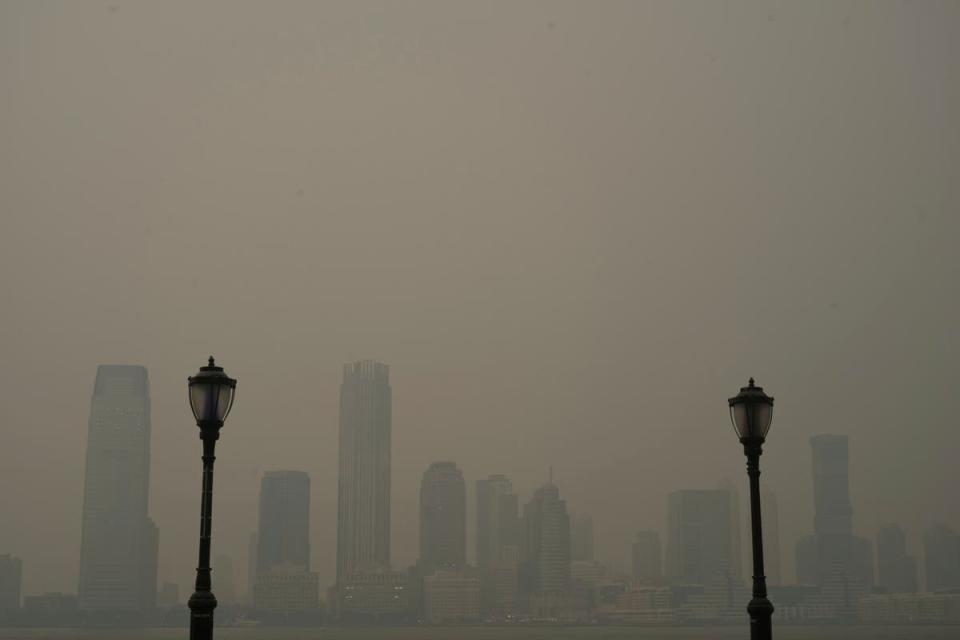
‘Apocalyptic’ photos capture smoky haze blanketing New York City
Bladerunner-esque skies in New York state
16:05 , Louise Boyle
The National Weather Service in Binghamton, New York, around 200 miles from the Canadian border, shared this vision of Blade Runner-esque skies on Wednesday morning.
“Sun is no longer visible, everything’s orange, the parking lot lights have come on, and we’re stuck at 50°F,” forecasters tweeted.
9:45 AM at NWS Binghamton. Sun is no longer visible, everything's orange, the parking lot lights have come on, and we're stuck at 50°F. pic.twitter.com/Ibu2oE2af5
— NWS Binghamton (@NWSBinghamton) June 7, 2023
NYC and DC public schools cancel outdoor activities as wildfire smoke plagues East Coast
15:45 , Louise Boyle
New York City and Washington DC have canceled outdoor activities in public schools as wildfire smoke drifting from Canada clouds the skies and creates unhealthy air conditions across the northeastern US.
Officials anticipate air quality to improve on 7 June but will likely deteriorate later in the day, according to forecasters, after eye-watering smoke and polluted conditions triggered alerts across the region. Thirteen states have issued air quality alerts.
Thick smoke was expected to drift across New York City and Philadelphia through Wednesday afternoon. Smoke is expected to reach as far south as South Carolina.
My colleague Alex Woodward has more below.
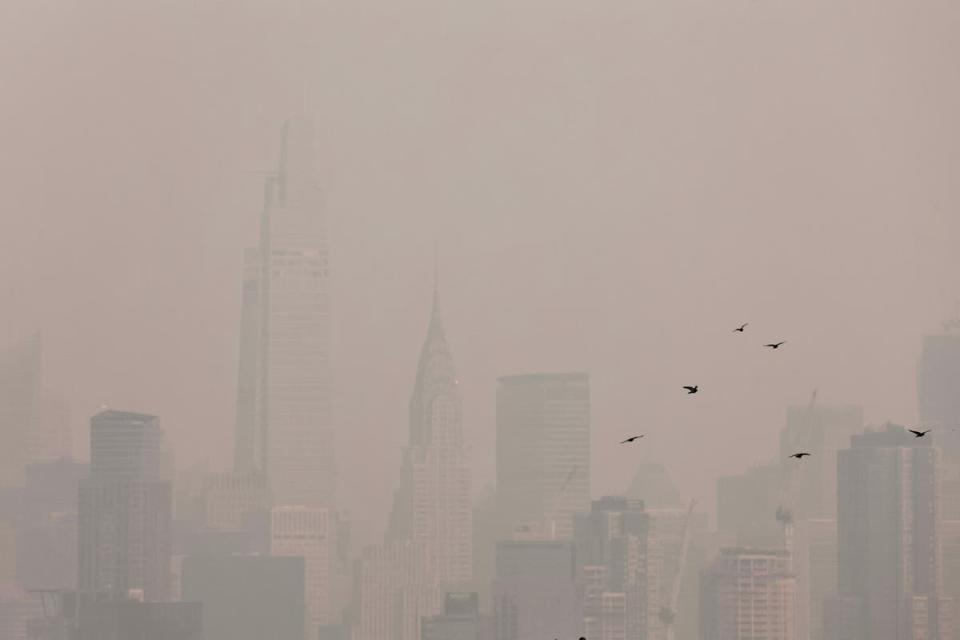
NYC and DC public schools cancel outdoor activities as smoke plagues East Coast
The New York City Mayor’s Office speaks about the air quality - watch live
15:32 , Louise Boyle
You can watch the New York City Mayor’s Office discuss the air quality issues at the link here.
Wildfires are causing heavy air pollution. So what’s causing the wildfires?
15:24 , Louise Boyle
Climate scientists agree: although fires are part of the ecosystem in some regions, the climate crisis is making them more frequent and intense.
Dozens of studies have linked larger wildfires to global heating that is caused by emissions from burning of fossil fuels. The last decade has been the hottest on record globally.
Snow melt earlier in the year combined with droughts and higher temperatures lead to drier soil and vegetation which is primed to burn.
In the US, the last National Climate Assessment, produced by the federal government, linked “human-caused climate change” with the rise in wildfires.
Wildfires and climate change form a vicious circle: the carbon pumped into the atmosphere by fires increases global heating, further drying out the land and vegetation, making it more susceptible to catching fire.
What is the Air Quality Index?
15:11 , Louise Boyle
The phrase “Air Quality Index” is cropping up across social media and in announcements from public officials - so what is it?The Air Quality Index (AQI) is what the US Environmental Protection Agency and other agencies use to report on air quality.
The index runs from 0-500 and the higher the AQI value, the greater the level of air pollution and the impacts on health.
AQI below 50 is good air quality - over 300 is dangerous. For context, the AQI in my part of the New York City area right now is 153 - which is an “unhealthy” level, particularly for young children and those with underlying health conditions like asthma and heart disease.
You can find out more about the air quality where you are here.
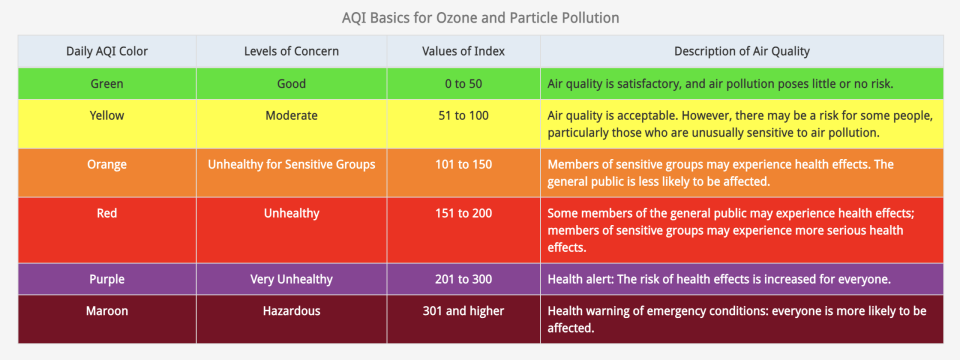
New York City wakes up to another smoke-filled day
14:24 , Louise Boyle
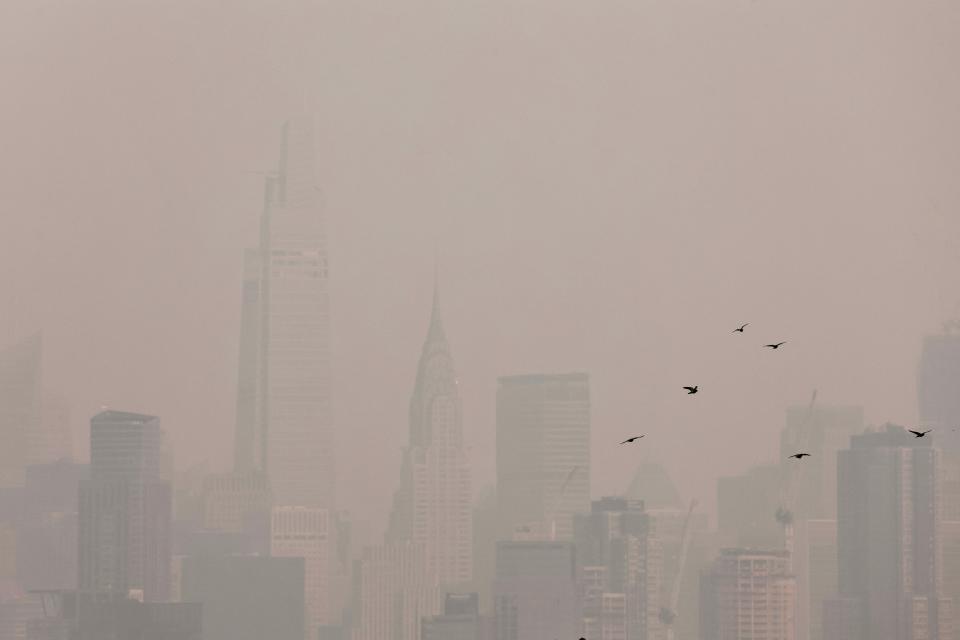
ICYMI: New York becomes ‘world’s most polluted’ metro city amid smoke from Canadian wildfires
13:15 , Stuti Mishra
New York City and large parts of the tri-state area continue to be under air quality alerts today as wildfires explode across Canada.
NYC was the world’s most polluted major city today surpassing Delhi, Baghdad, Doha, Kuwait and Dhaka, followed by Detroit on the sixth spot.
The air quality for New York stood at 174 on Wednesday, a level that is considered unhealthy for everyone as mayor Eric Adams urged residents to mask-up.
Here’s everything you need to know about the plummeting air quality and the advisories in place:
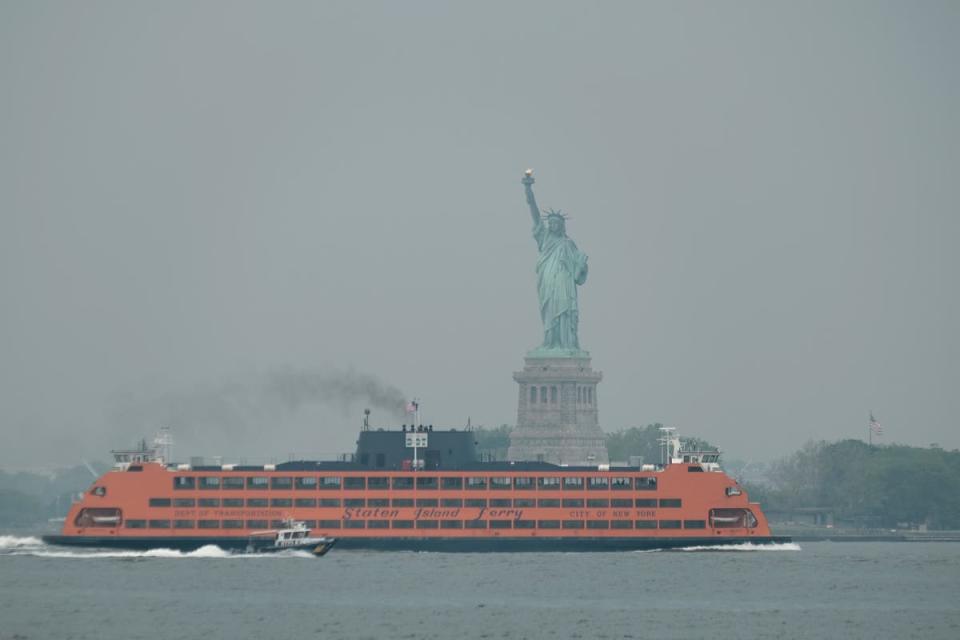
Air quality plummets in New York as wildfires rage in Canada
Do air purifiers work?
12:46 , Stuti Mishra
In the face of deteriorating outdoor air quality in New York and large parts of the Northeastern United States and Canada, many individuals seek refuge indoors, assuming that the air inside their homes or workplaces is safe and clean.
However, indoor air pollution can be a significant concern as well with pollutants from outside entering our houses. This is where air purifiers come into play, promising to remove harmful pollutants and improve indoor air quality.
But how effective an air purifier is in achieving cleaner and healthier indoor environments depends on several factors.
Air purifiers are designed to target specific pollutants, such as dust, pollen, pet dander, smoke, or volatile organic compounds (VOCs). Different air purifier models employ various filtration technologies, such as High-Efficiency Particulate Air (HEPA) filters, activated carbon filters, or electrostatic precipitators.
With raging wildfires, the fine particulate matter which is known as PM2.5 is increased, that is known impact respiratory system and cause cardiovascular diseases.
A good quality HEPA filter an cut smoke pollution indoors by about 50 to 80 per cent, some estimates suggest.
Air purifiers with HEPA filters can also be beneficial for individuals suffering from allergies. They can effectively trap and remove common allergens such as pollen, dust mites, mould spores, and pet dander, providing relief for allergy sufferers and improving overall comfort.
While activated carbon filters play a crucial role in eliminating unpleasant odours and reducing exposure to volatile organic compounds (VOCs) and other harmful chemicals.
To maximize the effectiveness of air purifiers, it is also important to consider the size of the purifier in relation to the room, as well as the Clean Air Delivery Rate (CADR) and air changes per hour (ACH) specifications.
Regular maintenance, such as filter replacements and proper cleaning, is essential to ensure optimal performance.
Washington DC braces for 'code red' air pollution today
12:00 , Stuti Mishra
The Washington DC area found itself under a code orange air quality alert yesterday, indicating high levels of pollution in the air that could pose health risks to vulnerable individuals.
Conditions today are expected to worsen for DC residents, potentially reaching code red levels.
Clean Air Partners — which provides air quality forecasts for the Washington-Baltimore region — has predicted code red conditions for Baltimore today while worsening conditions are expected to reach Washington tomorrow. Some areas will still be under code orange.
Code orange refers to the 101-150 range of the Air Quality Index, which ranges from 0-500. This range is considered unhealthy for vulnerable individuals and comes above moderate levels of air pollution.
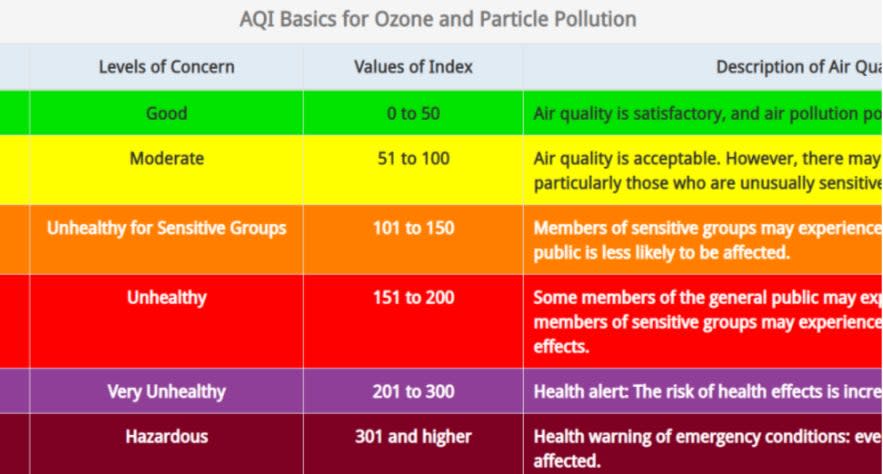
Code red, however, is the unhealthy range for all individuals where anyone stepping outside in the polluted air feel discomfort.
According to the EPA's AirNow webpage, during code red conditions, some members of the general public may experience health effects, while individuals from sensitive groups may encounter more serious health consequences.
What to do when air quality is 'unhealthy'
11:30 , Stuti Mishra
As the air quality takes a nosedive and fine particle pollution levels rise across the Northeastern United States and Canada due to raging wildfires, there are several health and safety alerts in place.
With AQI levels showing 174 for New York currently, authorities are urging residents to take appropriate measures to safeguard their health, particularly for those who are more vulnerable.
Air quality alerts specifically highlight the risk for "sensitive groups," encompassing children, older adults, and individuals with respiratory conditions like asthma or chronic obstructive pulmonary disease. Among these groups, children are especially susceptible due to their developing lungs and higher inhalation rates relative to body weight.
The impact of poor air quality is maximum for the lungs and heart.
Most advisories right now are urging residents to limit outdoor activities, especially during peak pollution hours. When venturing outside becomes necessary, residents are urged to wear a properly fitted mask designed to filter out fine particles like PM2.5.
Detroit most polluted after New York as Michigan's air quality remains poor
11:06 , Stuti Mishra
The most polluted city after New York is Detroit, which continues to remain in the top 10 list of polluted metropolitans on the IQAir chart.
The Swiss technology company that monitors air quality levels shows New York currently on top of the list, surpassing Delhi, Kuwait and Baghdad, while Detroit is currently at sixth spot above Dhaka and Kolkata.
When New York's pollution levels briefly came down yesterday, NYC and Detroit were on the second and third spot.
Here's how Michigan's AQI levels have been so far:
Air quality advisories have been in effect since Monday in parts of the Upper Peninsula of Michigan as smoke engulfed several cities bringing hazy skies.
Overnight areas in parts of the state were expected to see some improvement, however, Detroit remains in the "very poor" category.
On Wednesday, a brief relief is expected early morning but poor air quality is expected to continue for long.
Quebec looks for international support to fight wildfires
10:37 , Stuti Mishra
Canadian province of Quebec, which is battling over 160 wildfires, is looking internationally for support to deal with what federal officials say is shaping up to be among the country’s worst fire seasons ever.
With more than 480 wilderness firefighters on the ground, Quebec can fight around 30 fires, François Legault told reporters, adding that normally firefighters would come from other provinces to help.
“When I talk to the premiers of other provinces, they have their hands full,” Legault told a briefing in Quebec City.
Read more:
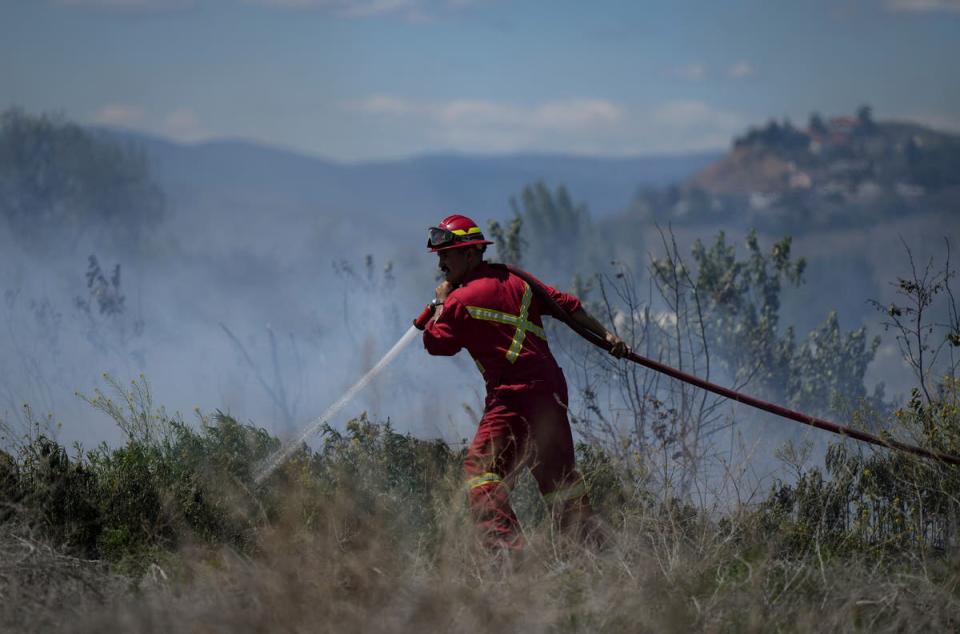
Canadian province of Quebec looks for international support to fight wildfires
All the air quality alerts in place in the US
10:00 , Stuti Mishra
An air quality advisory is in effect for several regions of New York state currently.
Yesterday the US Environmental Protection Agency (EPA) issued a poor air quality alert for New England, a day after parts of Illinois, Wisconsin and Minnesota received a similar advisory.
Last week, US officials as far south as Maryland, Baltimore, Virginia and Pennsylvania reported being impacted by the wildfires.
Here’s a summary of what’s being evaluated and some suggested precautions:

Canada wildfires lead to air-quality alerts in US, here's how to stay safe
Is the air quality going to improve in New York?
09:35 , Stuti Mishra
New York's air quality is expected to get better briefly this morning as smoke clears for a while. The city, however, will once again be engulfed in smoke as the day progresses.
There is no end in sight yet for the raging wildfires in Quebec that have contributed to the polluted air in New York as officials continue to struggle with controlling hundreds of blazes. More smoke is expected to come today and tomorrow out of Canada as a north-to-south-moving cold front comes.
New York state, Pennsylvania and the Mid-Atlantic are expected to see air quality plummet further.
However, as the weekend approaches, the wind is expected to flow northwesterly, clear away the skies a little and bring increased visibility. But as long as the fires continue to rage, the impact may be felt across the region depending on weather systems.
New York Road Runners urges people to not participate in Marathon
09:12 , Stuti Mishra
The New York Road Runners, organisers of the renowned New York City Marathon, have issued a cautionary message to runners residing in smoke-affected areas, urging them to not participate in marathon today on global running day.
In a tweet, the organisation urged members to adhere to health advisories and refrain from running.
June 7 is Global Running Day, but if you're in NYC or any affected area, please read and follow your city's health advisory regarding air quality, and consider running another day. pic.twitter.com/YPYfgr284b
— New York Road Runners (@nyrr) June 6, 2023
Research indicates that wildfire smoke may pose greater lung toxicity than urban air pollution. Strenuous exercise during the marathon coupled with inhaling compromised air quality could aggravate respiratory symptoms, especially for those with pre-existing conditions like asthma.
New York mayor urges vulnerable residents to mask up
08:51 , Stuti Mishra
Officials in New York are asking senior citizens and those with pre-exisiting conditions to wear a mask as air quality continues to remain in the "unhealthy" range in the city.
“If you are an older adult or have heart or breathing problems and need to be outside, wear a high-quality mask (e.g. N95 or KN95),” the office of mayor Eric Adams said in a statement last night. The city also urged New Yorkers to stay indoors when possible.
“Currently, we are taking precautions out of an abundance of caution to protect New Yorkers’ health until we are able to get a better sense of future air quality reports,” Mr Adams' office said.
Currently, New York is the most polluted major city, surpassing Delhi, as thick smoke from raging wildfires in Canada engulfs the Northeastern United States.
This is the first time in recent years that New Yorkers have been asked to mask up.
Video: Canadian wildfires cause eerie haze over Yankee Stadium in New York
08:30 , Stuti Mishra
Footage captures an eerie haze over Yankee Stadium in New York, as smoke from Canadian wildfires set off health alerts in the city.
Authorities in New York, Toronto and Ottawa warned residents about the health risks from air polluted by smoke from early summer wildfires in eastern Canada.
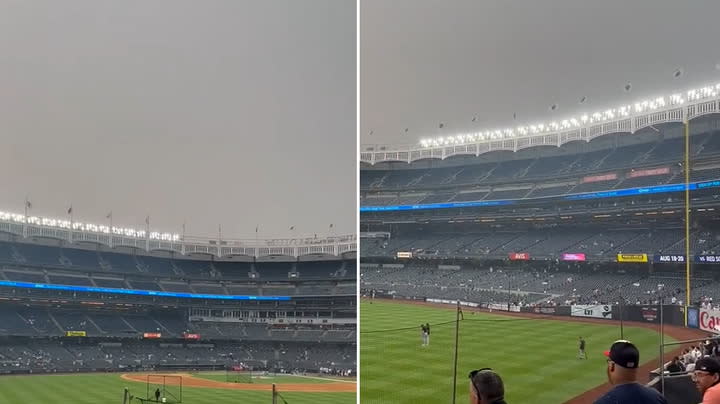
Canadian wildfires cause eerie haze over Yankee Stadium in New York
Satellite images shows grey smoke covering Northeastern US
08:10 , Stuti Mishra
Satellite images captured the vast scale of smoke covering the skies over the northeastern US and Canada from over a hundred wildfires raging in Quebec.
A time lapse video released by National Oceanic and Atmospheric Administration showed gray hazy smoke appearing alongside white clouds.
It's #TimelapseTuesday, and we are continuing to monitor the large amount of grayish smoke from Canadian wildfires drifting across the eastern U.S.
You can see it in stark contrast with the white clouds in this 7-hour loop via #GOESEast. pic.twitter.com/MWCOF1MQG3— NOAA Satellites (@NOAASatellites) June 6, 2023
A video from the Cooperative Institute for Research in the Atmosphere showed a "horribly smoky day in the Eastern US".
Today's horribly smoky day in the Eastern US as seen by satellite. pic.twitter.com/6iY5QjQqm8
— CIRA (@CIRA_CSU) June 7, 2023
New York again most polluted major city in world
07:50 , Stuti Mishra
New York is once again the most polluted major city in the world right now, according to live rankings by IQAir, an air quality monitoring technology company.
NYC, which held the top spot briefly yesterday as well, surpassed Delhi as smoke continued to fill the skies of the Northeastern United States and air quality plummeted further after sunset.
The AQI for NYC stands at 174, which is considered “unhealthy”.
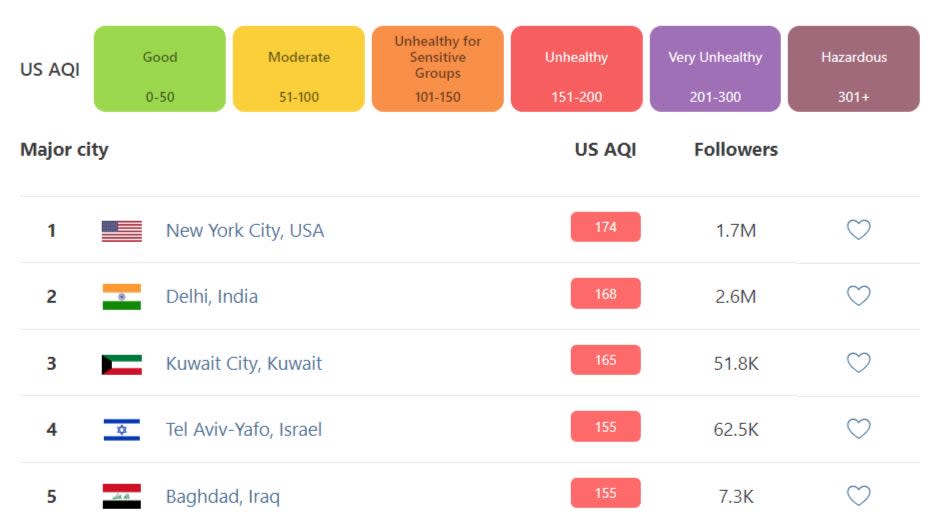
New York sees air quality get down to 'unhealthy'
07:30 , Stuti Mishra
Air quality in New York City yesterday evening plummeted to unhealthy levels.
The NYC metro weather service said the near surface smoke density from wildfires in Quebec was set to "peak" around sunset across the NYC Metro.
Residents reported reduced visibility as smoke continues to engulf the city.
Near surface smoke density from wildfires in Quebec will peak from now through sunset across the NYC Metro. Very poor/unhealthy air quality and reduced visibility is likely. Take it easy out there.
— New York Metro Weather (@nymetrowx) June 6, 2023
Why did New York residents see the sun and moon turn red?
07:15 , Stuti Mishra
Residents in northeastern US witnessed the moon turning red, an occurrence directly linked to smoke drifting down from the Canadian wildfires as it appears behind grey, hazy skies.
Today morning, early risers in the US saw the unusual colour on the moon. The odd red colour is something that has been noticed for a few days now in some parts as air quality continues to worsen.
New Jersey looks like the blood moon is rising once again today
— Rebecca (@schaefcake) June 7, 2023
Here's how this phenomenon works:
When the air is heavily polluted, it contains an increased concentration of fine particulate matter like smoke, dust and pollutants. These particles have the ability to scatter light in different ways, depending on their size and composition. In particular, smaller particles tend to scatter shorter wavelengths of light, such as blue and green, more effectively than longer wavelengths like red.
As a result, when sunlight or moonlight passes through a polluted atmosphere, the shorter wavelengths of light are scattered away, while longer wavelengths like red and orange are less affected and can reach the observer's eyes.
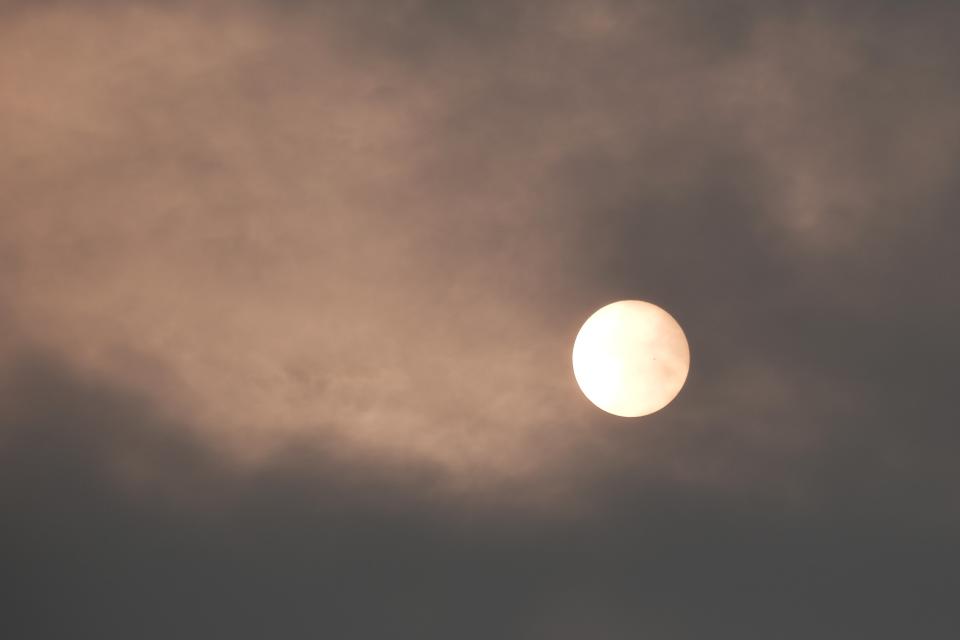
Canada facing its 'worst wildfire season ever'
06:38 , Stuti Mishra
More than 160 forest fires have broken out in Quebec province with at least 114 raging out of control as officials warned that this is shaping up to be Canada’s worst fire season ever.
More than 400 wildfires are raging across the country as leaders appealed for international help to bolster local fire crews. An additional 200 firefighters are coming from France and the US, and Quebec is also in talks with Costa Rica, Portugal and Chile as it searches for additional resources.
Fires have forced about 10,000 people from their homes in Quebec, with most of those in the northwestern Abitibi region and the eastern Côte-Nord region.
The effects of hundreds of wildfires burning in Quebec could be felt as far away as New York City and New England, blotting out skylines and causing health complications in several people.
Read more here.
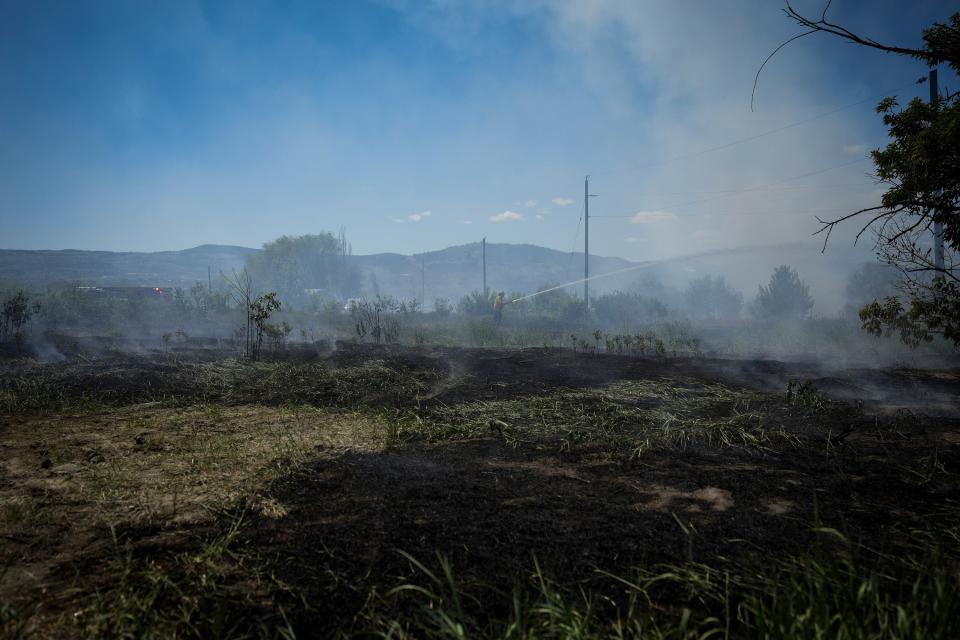
New York City 'worst polluted city' in the world as air quality plummets
06:17 , Stuti Mishra
New York City briefly surpassed Delhi to become the world's most polluted city for a few hours as smoke from raging wildfires in Canada engulfed the tri-state area and the northeastern US, bringing air quality down.
NYC currently stands at second spot just behind Delhi, with Detroit following at third. The US cities have become more polluted than Baghdad, Doha and Dhaka.
Air Quality Index levels surged above 200 in NYC, which is considered "very unhealthy", prompting health alerts and leading to a halt in outdoor activities for many schools.
The Independent's senior climate correspondent Louise Boyle has more details here:
05:47 , Stuti Mishra
Welcome to The Independent’s live blog with all the latest updates on raging wildfires in Canada and their impact on the air quality of New York and the northeastern United States.

